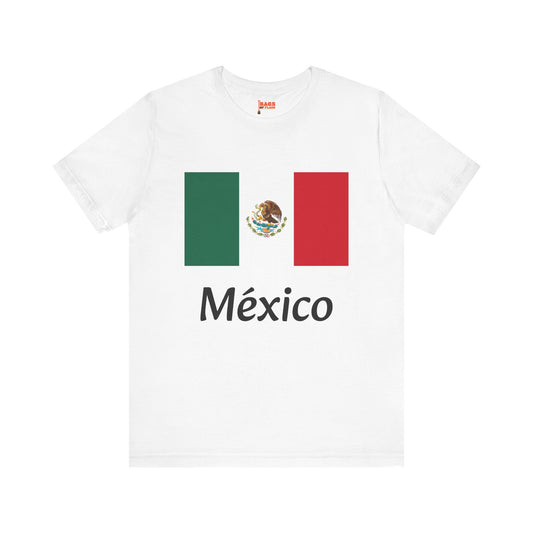-
Mexico Sweatshirt
Regular price $34.15 USDRegular priceUnit price / per -
México Sweatshirt
Regular price $34.15 USDRegular priceUnit price / per -
Mexico Flag Sweatshirt
Regular price $34.15 USDRegular priceUnit price / per -
Mexico Inspired Sweatshirt
Regular price $34.15 USDRegular priceUnit price / per -
Mexico Pillow
Regular price $22.65 USDRegular priceUnit price / per -
Mexico Backpack
Regular price $59.79 USDRegular priceUnit price / per -
Mexico Leather Patch Hat
Regular price $18.85 USDRegular priceUnit price / per -
Mexico Mug
Regular price $11.65 USDRegular priceUnit price / per -
Mexico Trucker Cap
Regular price $14.90 USDRegular priceUnit price / per -
México Hoodies
Regular price $34.40 USDRegular priceUnit price / per -
México T-shirts
Regular price $22.79 USDRegular priceUnit price / per -
Mexico Hoodies
Regular price $34.40 USDRegular priceUnit price / per -
Mexico T-shirts
Regular price $22.79 USDRegular priceUnit price / per -
Mexico Inspired Hoodies
Regular price $34.40 USDRegular priceUnit price / per -
Mexico Flag Hoodies
Regular price $34.40 USDRegular priceUnit price / per -
Mexico Inspired T-shirt
Regular price $22.79 USDRegular priceUnit price / per -
Mexico Flag on T-shirt
Regular price $22.79 USDRegular priceUnit price / per -
Embroidered Mexico Flag – Premium Nylon Outdoor Flag
Regular price $56.22 USDRegular priceUnit price / per -
Premium Mexico Flag – Double-Sided Nylon
Regular price $56.28 USDRegular priceUnit price / per -
Mexico Flag - Embroidered
Regular price $52.08 USDRegular priceUnit price / per
Collection: Mexico
The Mexican flag symbolizes pride and identity for the Mexican people. With its vibrant colors and meaningful symbols, the flag holds a significant place in the country's history and culture. We will delve deeper into the Mexico flag, exploring its design, historical context, symbolism, current relevance, and additional interesting facts.
Overview of the Mexico Flag

The flag of Mexico is instantly recognizable, characterized by its three vertical stripes of green, white, and red, with the national coat of arms centered in the white stripe. This Symbolic design, depicting an eagle perched atop a prickly pear cactus with a serpent in its beak, is rich in symbolism and rooted in the country's ancient Aztec mythology. The tricolor design, originating from Mexico's fight for independence, has undergone several modifications since its initial conception in the early 19th century. The specific hues of green, white, and red have been a constant feature, embodying the nation's identity and its journey through history. This flag not only represents the sovereignty and pride of the Mexican nation but also tells a story of resilience and hope, encapsulating the essence of Mexico's struggle for independence and its enduring spirit.
Historical Context of the Flag
The historical evolution of the Mexican flag is as rich and complex as the country's history. The earliest version of the flag was conceived following Mexico's declaration of independence from Spanish rule in 1810. This pivotal moment set the stage for creating a symbol that would unite the newly independent nation. As we recognize it today, the flag traces its origins back to the Army of the Three Guarantees, formed in 1821. It represented the union of Mexican groups with differing ideologies for the common goals of independence, religion, and unity.
Throughout the 19th and 20th centuries, the flag underwent several revisions, reflecting the political and social changes occurring within the country. Each iteration adjusted the emblem's design, though the flag's core elements – the green, white, and red vertical stripes and the eagle with a serpent – have remained constant. These modifications often parallel significant historical events, such as the Reform War and the Mexican Revolution, highlighting the flag's integral role in Mexico's journey through times of conflict and peace.
The adoption of the current flag design on September 16, 1968, marked a significant moment, further solidifying the flag's symbolism and importance in representing the ideals and aspirations of the Mexican people. This date, closely associated with Mexico's Independence Day, underscores the flag's enduring connection to the country's quest for sovereignty and self-determination.
Symbolism Behind the Flag

The vivid colors and emblem found on the Mexico flag carry profound meanings deeply rooted in the nation's past and aspirations for the future. The green stripe signifies hope and prosperity, echoing the sentiments of the independence movement that led to the nation's birth. The white middle stripe represents the purity and integrity of the Mexican people, serving as a reminder of the importance of unity and peace within the country. Red, the final color, commemorates the bravery and the blood of the national heroes who sacrificed their lives for freedom and justice.
Central to the flag's design is the national coat of arms, which depicts an eagle holding a serpent in its beak while perched on a prickly pear cactus. This emblem is a powerful representation of Aztec mythology, symbolizing Tenochtitlan's (the Aztec capital) mythical foundation and the strength and resilience of the Mexican people. Together, these elements encapsulate the spirit of Mexico, weaving a narrative of struggle, sovereignty, and unity that continues to resonate with Mexicans today.
Current Relevance of the Flag
In modern Mexico, the flag continues to be a prominent fixture in the nation's life, prominently featured in ceremonies, public holidays, and at critical landmarks across the country. It symbolizes unity and patriotism, particularly during events of national significance like Independence Day and the Revolution Day Memorial. Its presence in military parades and government functions underscores its role as a symbol of sovereignty and national pride. Beyond official usage, the flag also finds its way into civil society, where it is a common sight at cultural events, sports competitions, and educational institutions, helping to foster a sense of national identity among Mexicans.
While the flag is a source of pride, it has also been at the center of debates and controversies, particularly in its usage during political protests. These discussions highlight the flag's role as a national emblem and a potent symbol within the broader discourse on Mexican identity, politics, and society. Its relevance extends beyond mere representation, touching upon issues of freedom of expression and the ongoing dialogue about what it means to be Mexican in today’s world.
Additional Facts About the Mexico Flag
Among the unique protocols associated with the Mexico flag, there is a specific manner in which it must be displayed. When hung vertically, the green stripe should always be positioned on the observer's right side, which might appear on the left from a frontal view. This ensures the proper representation of the flag's colors as intended. Another patriotic custom involves the citizens' show of respect towards the flag; during the rendition of the national anthem, it is a widespread practice for individuals to render a salute as a gesture of honor and reverence to their nation's symbol.
Furthermore, despite the flag's long history of modifications and adaptations, the design we see today has remained consistent for over five decades, signifying a period of stability and continuity in the nation's identity since its last alteration in 1968. Interestingly, an earlier version existed shortly after Mexico gained independence before the current design was adopted. This version also utilized the tricolor scheme and included a central emblem, reflecting the continuity of these elements as core identifiers of the Mexican flag throughout its history.
These nuances and rituals surrounding the Mexican flag not only underscore its significance in the country's cultural and patriotic expressions but also highlight the deep respect and adoration the Mexican people have for their national emblem.








































